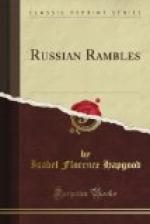Returning to the wharf with a fresh stock of patience, we watched the river traffic and steamers of rival lines, which had avoided sand-banks, as they took in their fuel supplies of refuse petroleum from the scows anchored in mid-stream, and proceeded on their voyage to Astrakhan. Some wheelbarrow steamers, bearing familiar names, “Niagara” and the like, pirouetted about in awkward and apparently aimless fashion.
Passengers who seemed to be better informed than we as to the ways of steamers began to make their appearance. A handsome officer deposited his red-cotton-covered traveling-pillow and luggage on the dock and strolled off, certain that no one would unlock his trunk or make way with his goods. The trunk, not unusual in style, consisted of a red-and-white tea-cloth, whose knotted corners did not wholly repress the exuberance of linen and other effects through the bulging edges.
A young Tatar, endowed with india-rubber capabilities in the way of attitudes, and with a volubility surely unrivaled in all taciturn Kazan, chatted interminably with a young Russian woman, evidently the wife of a petty shopkeeper. They bore the intense heat with equal equanimity, but their equanimity was clad in oddly contrasting attire. The woman looked cool and indifferent buttoned up in a long wadded pelisse, with a hot cotton kerchief tied close over ears, under chin, and tucked in at the neck. The Tatar squatted on his haunches, folded in three nearly equal parts. A spirally ribbed flat fez of dark blue velvet, topped with a black silk tassel, adorned his cleanly shaven head. His shirt, of the coarsest linen, was artistically embroidered in black, yellow, and red silks and green linen thread in Turanian designs, and ornamented with stripes and diamonds of scarlet cotton bestowed unevenly in unexpected places. It lay open on his dusky breast, and fell unconfined over full trousers of home-made dark blue linen striped with red, like the gussets under the arms of his white shirt. The trousers were tucked into high boots, slightly wrinkled at the instep, with an inset of pebbled horsehide, frosted green in hue, at the heels. This green leather was a part of their religion, the Tatars told me, but what part they would not reveal. As the soles were soft, like socks, he wore over his boots a pair of stiff leather slippers, which could be easily discarded on entering the mosque, in compliance with the Moslem law requiring the removal of foot-gear.
Several peasants stood about silently, patiently, wrapped in their sheepskin coats. Apparently they found this easier than carrying them, and they were ready to encounter the chill night air in the open wooden bunks of the third-class, or on the floor of the fourth-class cabin. The soiled yellow leather was hooked close across their breasts, as in winter. An occasional movement displayed the woolly interior of the tulup’s short, full ballet skirt attached to the tight-fitting body. The




